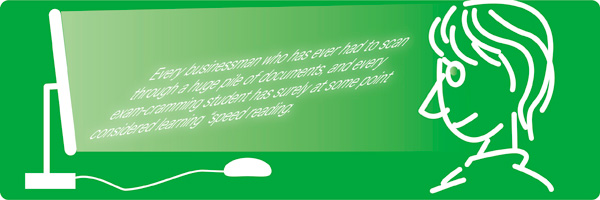- トップページ
- Fantastic Voyagers
- A new kind of high speed reading

A new kind of high speed reading
Research towards a dream display for speed reading
Wouldn’t you like to be able to read faster, but without any special training?
A new kind of display may make that possible.
Every businessman who has ever had to scan through a huge pile of documents, and every exam-cramming student has surely at some point considered learning “speed reading.” However, the problem with all such techniques and methods is that they invariably tend to require quite a lot of effort on the part of the reader before they become of any use.
Well then, what if there was a way to read faster without any special training at all? The research of Professor Toshio Kawashima at Future University Hakodate is pointing towards one such possibility.
In the first place, our eyes can only focus on objects that fall within a tiny area on the retina called the fovea centralis, which has a diameter of less than 1 mm. Outside of that area, the eye can only capture vague movements. When something happens in the periphery, the gaze (attention) is turned in that direction. It’s the same when we’re reading. We follow the text by instantly switching back and forth between the part currently in focus and the next text segment. When reading Japanese text, the experienced reader’s attention apparently jumps from Chinese character to Chinese character, barely glancing at the kana characters in between. (This is the reason why text written only in hiragana is so hard to read.) This means that if the time between these jumps could be shortened, as a result it should also be possible to read the whole text faster.
Professor Kawashima’s idea was that if you could make the text itself behave in such a way that it directs the reader’s gaze to the next appropriate point of attention, the reading speed should increase.
The objection that “books are printed, so the characters can’t move” is of course already obsolete. These days, we are already all used to reading great quantities of texts and writings on our computer screens and mobile phones. In most offices, “documents” no longer refer to printed sheets of paper but to data files, and matters to be investigated are checked via Internet search engines rather than in fusty volumes. Professor Kawashima’s speed reading research focuses on the displays we use.
In an experiment using sample texts from newspaper editorials, the researchers found that the gaze of the test subjects smoothly followed the text when it was “divided into groups of seven characters swinging slightly up and down” according to the reader’s pace. The results also showed that there was no loss of comprehension and that the test subjects didn’t skip any of the contents. The most interesting thing, however, was that even subjects who had been rather slow readers before were able to develop significant speed reading skills after a few trials.
The hope is that this research will lead to the development of displays that can automatically detect the reader’s gaze and raise the reading speed accordingly. A pacemaker for reading, as it were. Digital devices that bring out dormant human capabilities are no longer a dream.
